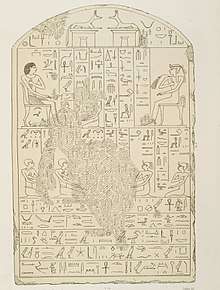Hatshepsut (king's daughter)

Hatshepsut was an Ancient Egyptian king's daughter of the 13th Dynasty, around 1750 BC. She is known from a limestone stela now in the Cairo Egyptian Museum (CG 20394) and found at Abydos,[1] where it is stated that she was the daughter of a king's wife Nofret. The name of her royal father is not recorded here. The queen Nofret is not known from other sources.[2] Hatshepsut appears on this stela as wife of the military man Nedjesankh/Iu who had a second wife with the name Nubemwakh. On the stela is also mentioned her daughter, the lady of the houses Nebetiunet. A king's daughter Hatshepsut is also known from a scarab seal.[2] In 2017 there was discovered a 13th Dynasty pyramid at Dahshur. In the pyramid was found a stone slab with pyramid texts[3] and the name of the king Ameny Qemau. In the same pyramid was found a canopic box naming the king's daughter Hatshepsut.[4]
It must in the very moment remain unknown whether these women with the name Hatshepsut are identical.
References
- ↑ H.O. Lange, H. Schäfer, Grab- und Denksteine des Mittleren Reichs, Theil I: Text zu No. 20001-20399, Berlin, 1902, pp. 393–4
- 1 2 K.S.B. Ryholt: The Political Situation in Egypt during the Second Intermediate Period, c.1800–1550 BC, Carsten Niebuhr Institute Publications, vol. 20. Copenhagen: Museum Tusculanum Press, 1997, ISBN 8772894210, p. 246
- ↑ Ein neues Fragment der Pyramidentexte ist in der Pyramide des Ameny Qemau gefunden (identified by Ivan Bogdanov)
- ↑ Owen Jarus: Burial Chamber of Princess Possibly Found in Ancient Egypt Pyramid, in Live Science